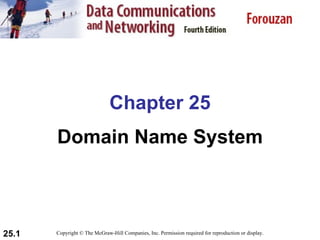
Chapter 25
- 1. Chapter 25 Domain Name System Copyright © The McGraw-Hill Companies, Inc. Permission required for reproduction or display.
- 2. Figure 25.1 Example of using the DNS service
- 3. 25-1 NAME SPACE To be unambiguous, the names assigned to machines must be carefully selected from a name space with complete control over the binding between the names and IP addresses. Flat Name Space Hierarchical Name Space Topics discussed in this section:
- 4. 25-2 DOMAIN NAME SPACE To have a hierarchical name space, a domain name space was designed. In this design the names are defined in an inverted-tree structure with the root at the top. The tree can have only 128 levels: level 0 (root) to level 127. Label Domain Name Domain Topics discussed in this section:
- 5. Figure 25.2 Domain name space
- 6. Figure 25.3 Domain names and labels
- 7. Figure 25.4 FQDN and PQDN
- 8. Figure 25.5 Domains
- 9. 25-3 DISTRIBUTION OF NAME SPACE The information contained in the domain name space must be stored. However, it is very inefficient and also unreliable to have just one computer store such a huge amount of information. In this section, we discuss the distribution of the domain name space. Hierarchy of Name Servers Zone Root Server Primary and Secondary Servers Topics discussed in this section:
- 10. Figure 25.6 Hierarchy of name servers
- 11. Figure 25.7 Zones and domains
- 12. A primary server loads all information from the disk file; the secondary server loads all information from the primary server. When the secondary downloads information from the primary, it is called zone transfer. Note
- 13. 25-4 DNS IN THE INTERNET DNS is a protocol that can be used in different platforms. In the Internet, the domain name space (tree) is divided into three different sections: generic domains, country domains, and the inverse domain. Generic Domains Country Domains Inverse Domain Topics discussed in this section:
- 14. Figure 25.8 DNS IN THE INTERNET
- 15. Figure 25.9 Generic domains
- 16. Table 25.1 Generic domain labels
- 17. Figure 25.10 Country domains
- 18. Figure 25.11 Inverse domain
- 19. 25-5 RESOLUTION Mapping a name to an address or an address to a name is called name-address resolution. Resolver Mapping Names to Addresses Mapping Addresses to Names Recursive Resolution Caching Topics discussed in this section:
- 20. Figure 25.12 Recursive resolution
- 21. Figure 25.13 Iterative resolution
- 22. 25-6 DNS MESSAGES DNS has two types of messages: query and response. Both types have the same format. The query message consists of a header and question records; the response message consists of a header, question records, answer records, authoritative records, and additional records. Header Topics discussed in this section:
- 23. Figure 25.14 Query and response messages
- 24. Figure 25.15 Header format
- 25. 25-7 TYPES OF RECORDS As we saw in Section 25.6, two types of records are used in DNS. The question records are used in the question section of the query and response messages. The resource records are used in the answer, authoritative, and additional information sections of the response message. Question Record Resource Record Topics discussed in this section:
- 26. 25-8 REGISTRARS How are new domains added to DNS? This is done through a registrar, a commercial entity accredited by ICANN. A registrar first verifies that the requested domain name is unique and then enters it into the DNS database. A fee is charged.
- 27. 25-9 DYNAMIC DOMAIN NAME SYSTEM (DDNS) The DNS master file must be updated dynamically. The Dynamic Domain Name System (DDNS) therefore was devised to respond to this need. In DDNS, when a binding between a name and an address is determined, the information is sent, usually by DHCP to a primary DNS server. The primary server updates the zone. The secondary servers are notified either actively or passively.
- 28. 25-10 ENCAPSULATION DNS can use either UDP or TCP. In both cases the well-known port used by the server is port 53. UDP is used when the size of the response message is less than 512 bytes because most UDP packages have a 512-byte packet size limit. If the size of the response message is more than 512 bytes, a TCP connection is used.
- 29. DNS can use the services of UDP or TCP using the well-known port 53. Note
